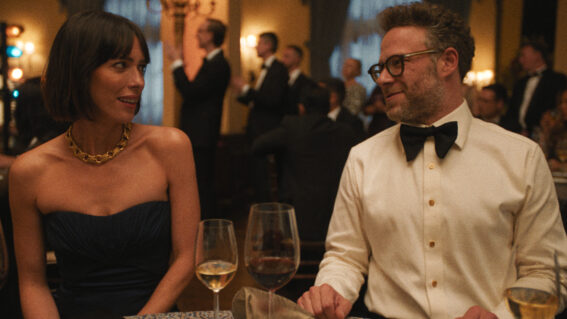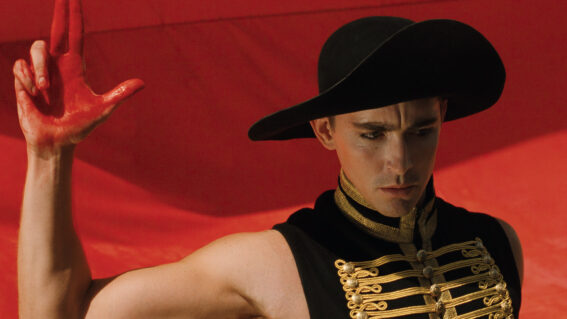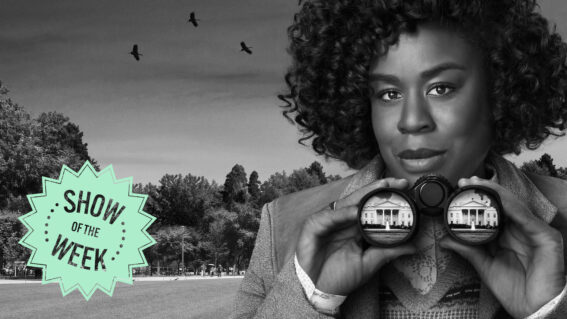The 25 most beautiful cinemas in Australia
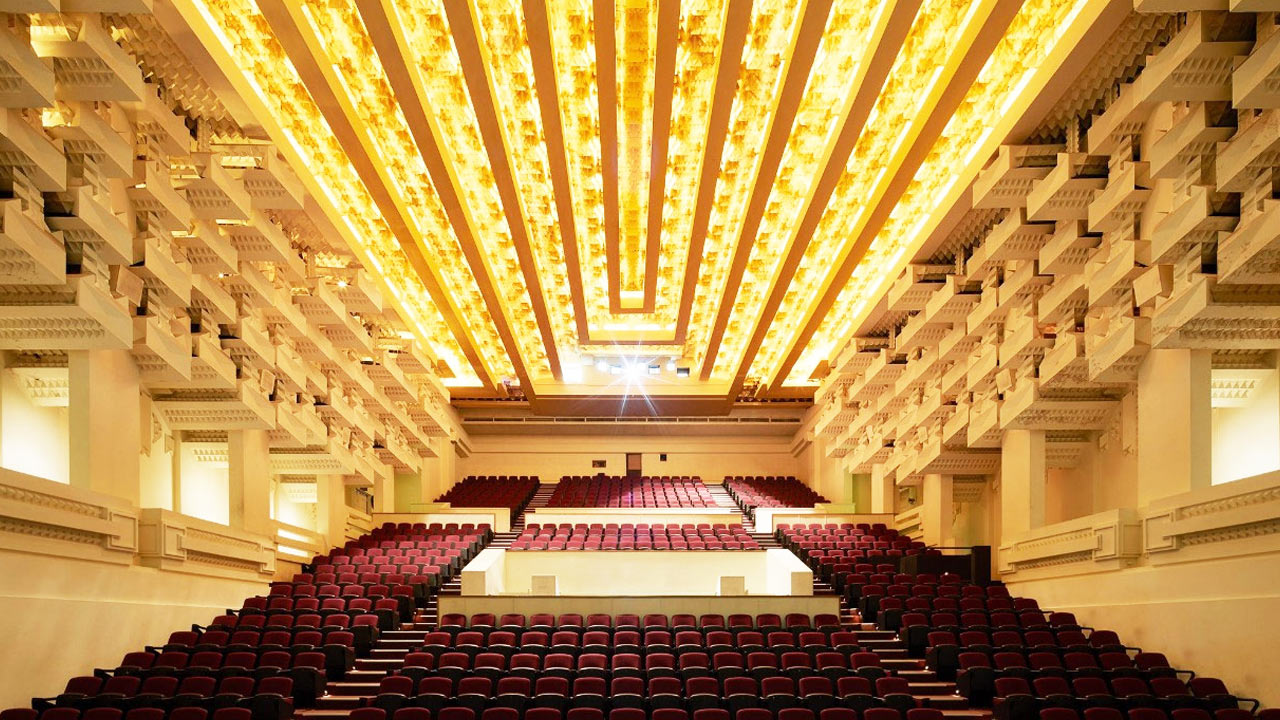
While some movie lovers would happily watch a classic while sitting on a log in a remote jungle and still be content, there are many who find the decor, spirit and history of the cinema an essential element of their movie-going experience. The rise of streaming services and the increasing affordability of home cinema setups has meant that the act of attending a cinema is no longer to be taken for granted by venue operators and the cinema industry.
Since it is no longer necessary to go out to see a movie with high quality sound and vision, and especially post-COVID, there’s an onus upon cinema owners to attract viewers back to their venues with something that their lounge rooms can’t offer.
It may be luxury seating; it may be historic movie paraphernalia adorning the foyer and bar; it may be on-site dining or cocktail-shaking bartenders. These 25 Australian movie theatres have something special—something beautiful about them that elevates the cinema experience beyond simply the film itself. Make it your plan to visit all of them, or perhaps to find a local gem that you weren’t aware of.
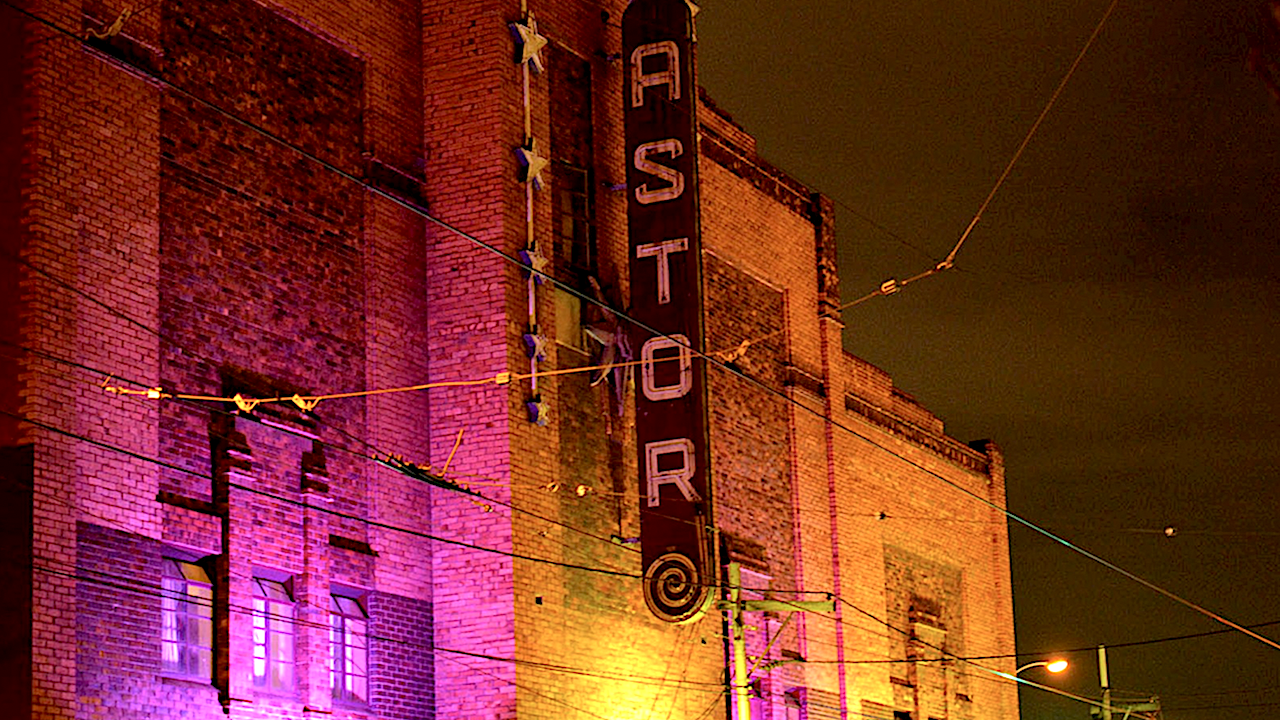
The Astor, St Kilda, VIC
Melbourne’s heritage-listed Astor Theatre has had a colourful life. From 1913, the site was a vaudeville theatre and cinema named the Diamond Theatre (later the Rex), with livery stables attached. It was a motor garage before partial demolition in the 1930s, with the same architect—Ron Morton Taylor—who designed the Forum Theatre on Flinders Street responsible for this beautiful art deco theatre, which officially opened on April 3, 1936.
It is grand from the outside, set apart from the ruckus of Chapel Street shops and cafes, demanding attention on the corner of Dandenong Road. Inside, the double level auditorium is a rarity in Melbourne theatres, as are the stalls and dress circle. The external facade is defined by distinctive 1930s jazz modern-style beige and dark brown brickwork, an illuminated neon sign and a corrugated iron roof. The interior is equally as regal, boasting a wrought iron balustrade, tiered ceilings and the terrazzo floor in the entry foyer.
In the theatre, the single screen is covered by lush golden curtains, indicating that—upon parting—a special occurrence is imminent. The Astor‘s auditorium seating and fixtures are protected from interference by the heritage listing of the building, so while they may lack the plush comfort of modern seating, their historical charm attracts discerning cinema goers.
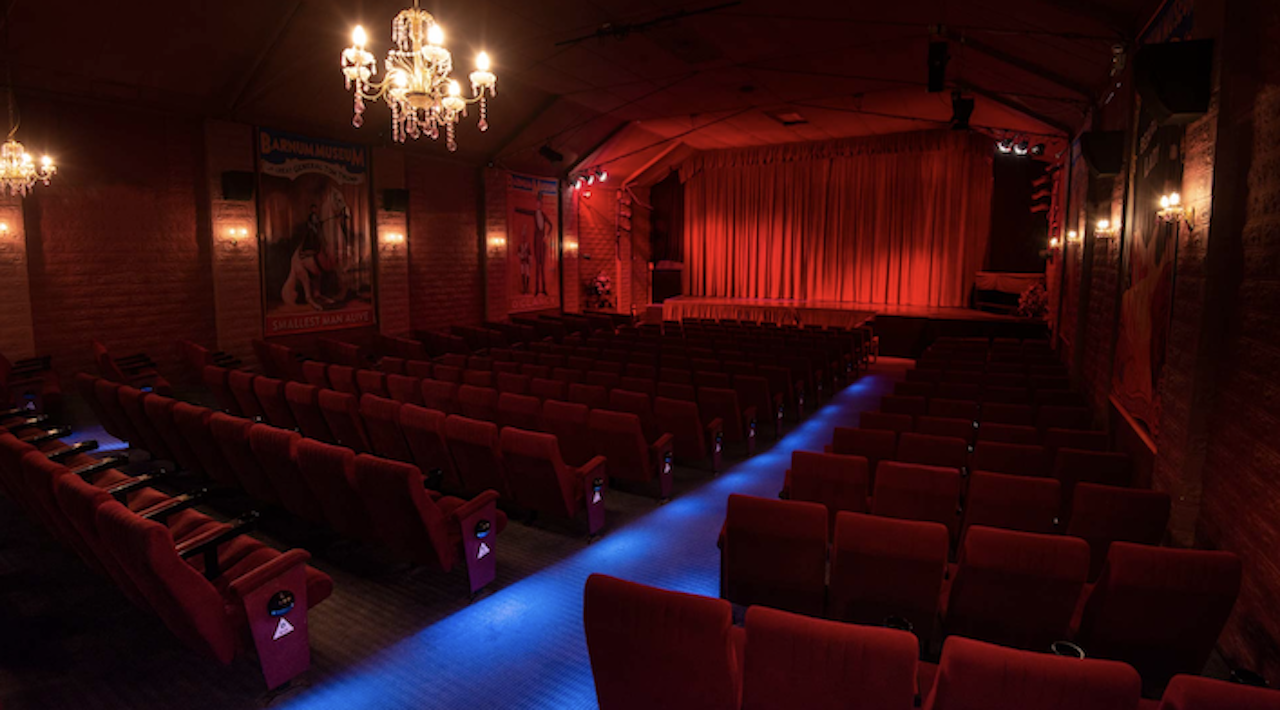
The Avoca Beach Theatre, Avoca Beach, NSW
If the Avoca Beach Picture Theatre was supplanted onto the Greek island Santorini, it wouldn’t look at all out of place. The white-brick facade, lit by amber lighting and dripping with fresh vines and fairy lights outside, is enormously romantic. Outdoor seating and slatted wooden doors allow patrons to take in the warm summer nights pre- and post-film. The interior boasts a checkerboard floor, which harks back to the late 1940s era of design.
The cinema began in the front garden of the Hunter family’s home, and has been owned by four generations of the family since. What began as a 500 seat cinema with a bank and real estate business within now operates as a modern(ish) cinema with a cafe, wine bar, souvenir shop and outdoor screenings when the weather permits.

The Capitol, Melbourne, VIC
In Melbourne’s CBD, The Capitol is an art deco theatre that remains grandly original. The oldest of Melbourne’s large movie palaces—many of which were opened in the late 1920s—The Capitol was designed by American architects Walter Burley and Marion Mahony Griffin. Gloriously decadent decor, a highly-detailed geometric ceiling adorned with thousands of coloured lamps, and abstract motifs could be kitsch in any setting other than this spacious, handsome building. In the 1960s, a heritage conservation campaign saved The Capitol from demolition, though a section of the original street-level foyer was sacrificed to become a shopping arcade.
The Capitol was bought by RMIT in 1999 for use as a lecture theatre. Between 2014 and 2019, a restoration project led to a rejuvenated cinema space that has been the home of film festivals, events and performances. The refurbished Capitol retains the dress circle lobbies, though no longer subdivided, and the 1960s foyer and the main auditorium. Melbourne-based architecture firm Six Degrees was behind the installation of modern theatre lighting systems, upgrading the coloured ceiling lighting to LED (with the ability to accommodate various lighting configurations synchronised to sound), new seating, and lift access.
The theatre seats 580, significantly less than the original 2000 seats that were partially demolished in the building of the ground-floor Capitol Arcade in the 1960s. The upstairs lounge areas maintain the broad pillars adorned by glass mosaic. The original carpets from the 1920s were used to recreate new carpets, retaining the same colour scheme.
Six Degrees architect Peter Malatt says, “Our involvement with RMIT since 1999 on the repurposing and restoration of the Capitol has been an amazing and fulfilling journey to bring back to life one of Melbourne’s architectural jewels. In doing so, we hope it has made this building of world importance sustainable and relevant for another 100 years.”
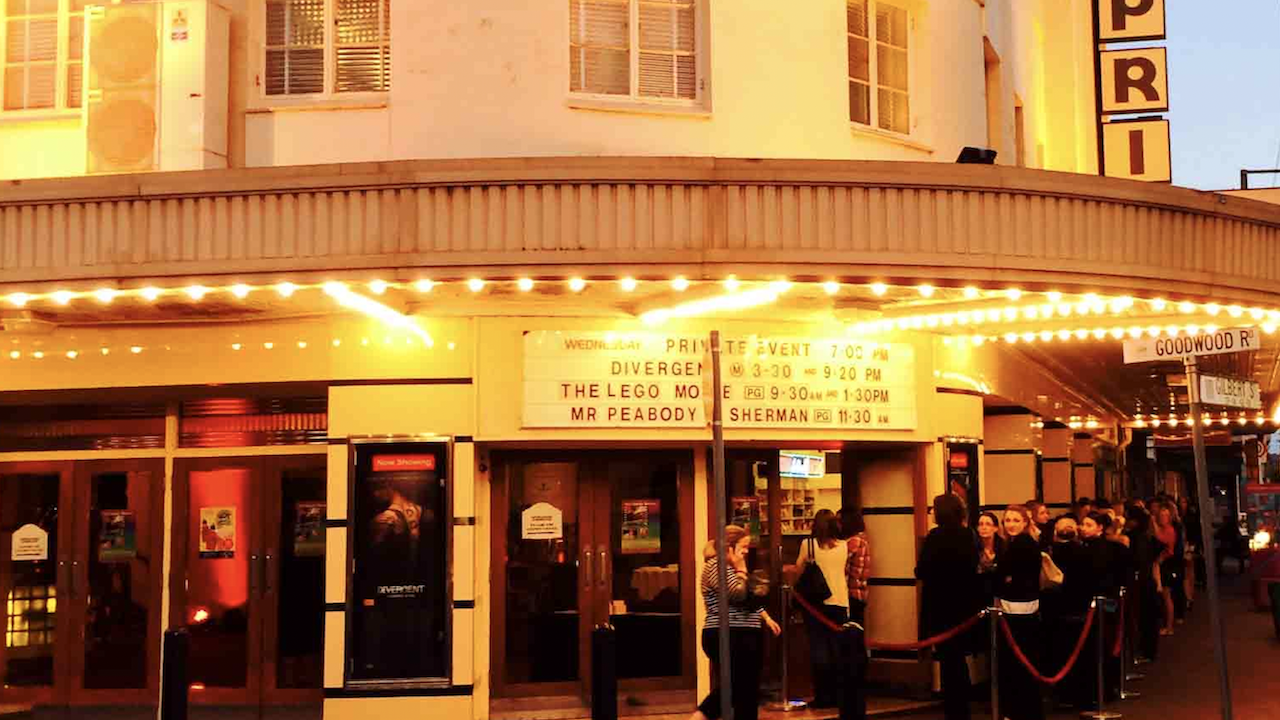
The Capri Theatre, Adelaide, SA
The grand curved surfaces of The Capri‘s facade hark back to its art deco-inspired origins in 1941. The heritage-listed building is, in itself, cinematic in scope, prominently located on a prime corner spot in Adelaide’s Goodwood. Housed within the beautiful edifice is a Wurlitzer theatre organ—its 13 pipes on display in the main auditorium, still used for recitals and to accompany film screenings.
A renovation artfully restored the original 1941 carpeting design, along with a replica art deco fireplace, mirror, club lounges and circular column seating. The single-screen cinema seats 750 over two levels, including double-seater lounges upstairs. Notably, the cinema is run as a not-for-profit organisation by the Theatre Organ Society of Australia, which purchased the cinema in 1978. The sleek exterior was repainted in 2016 after a fundraising appeal to coincide with the theatre’s 75th anniversary.
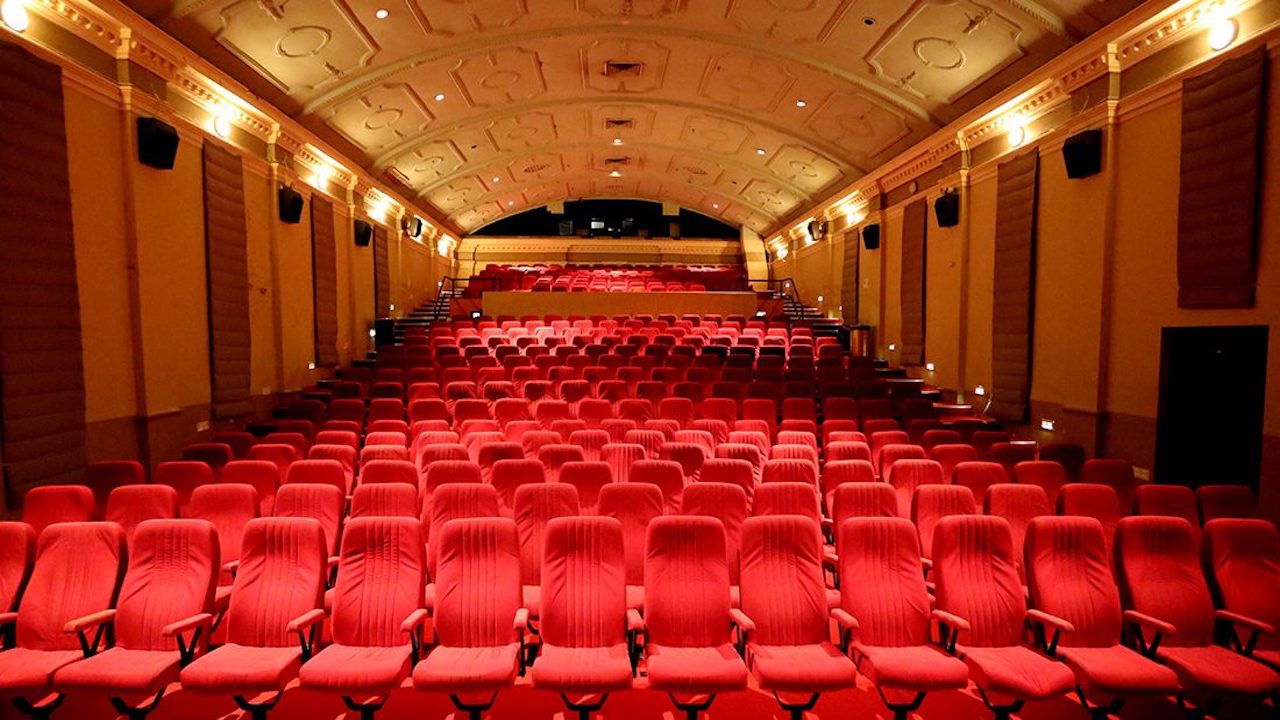
The Chauvel Cinema, Paddington, NSW
The heritage-listed Paddington treasure, Chauvel Cinema, opened in 1977 as a single screen cinema operating from what was once the ballroom of the grand Paddington Town Hall. The fully sprung floor, perfect for dancing, remains intact under the seating. In 1995, a second screen was added. Though the cinema is relatively modern compared to some of the other examples here, the building was opened in 1891, an elegant ode to Victorian architecture, complete with a 32 metre-high clock tower.
At two storeys high, the brick building is a study in classical details, with regal rows of Roman-arched windows, a balustered parapet and a domed tower. There is a sense of grandeur that permeates the building well beyond its corner position.
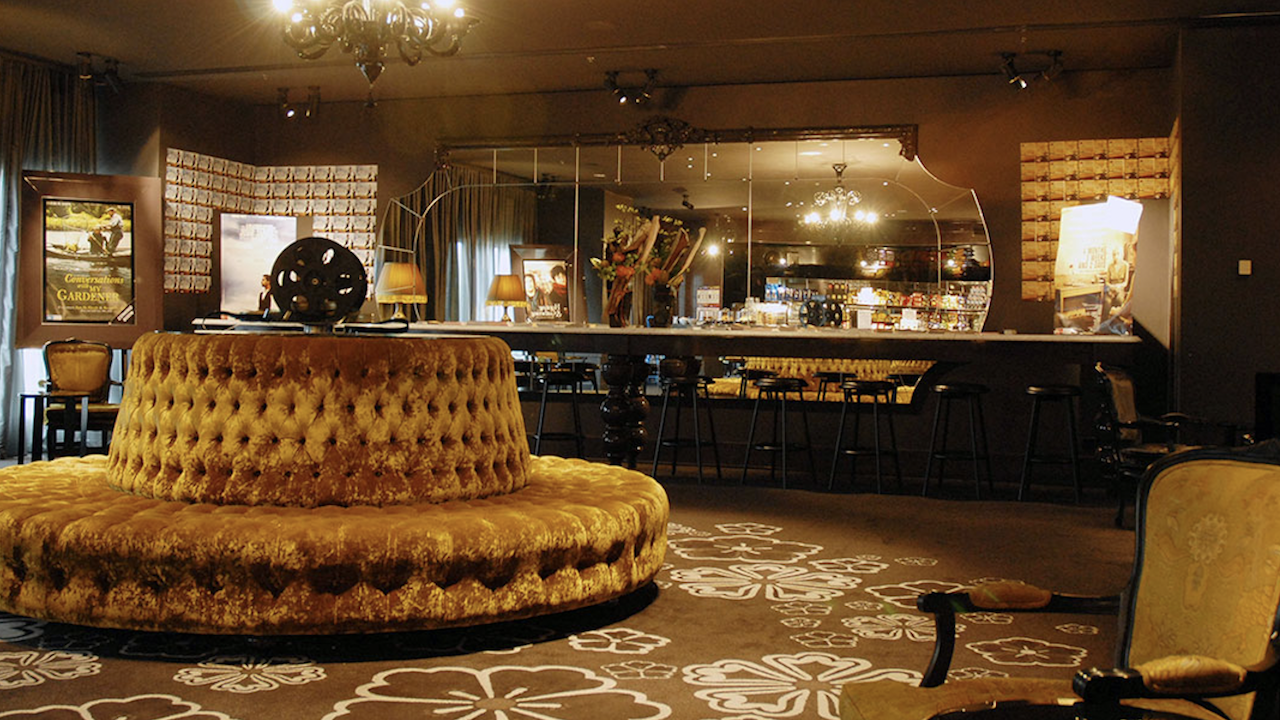
Como, South Yarra, VIC
From the outside, the Como cinema in South Yarra is nothing special. Located in a high-rise building—the Como Shopping Centre—on busy Chapel Street, the interior glitz of the actual cinema remains a hidden treasure. A generous makeover in 2005 updated the venue, originally opened in 1994, to better reflect the aesthetic discernment of art house cinema attendees.
The Como cinema was remodelled by Hecker Guthrie, inspired by a boutique hotel aesthetic. It was fitting, since the Como cinema also offers fine dining and a bar decked with champagne and barista-made coffee. Part of the fifth largest cinema group in Australia, Palace Cinemas, Como has been architect-designed with the intention of drawing loyal members willing to spend a little more for a sophisticated and elegant cinema experience.
Once a hairdressing salon, the Como houses nine screens—three of which are Platinum, featuring fully reclining leather seats. Opulent fittings and in-cinema service attract cinema lovers who appreciate the finer things.
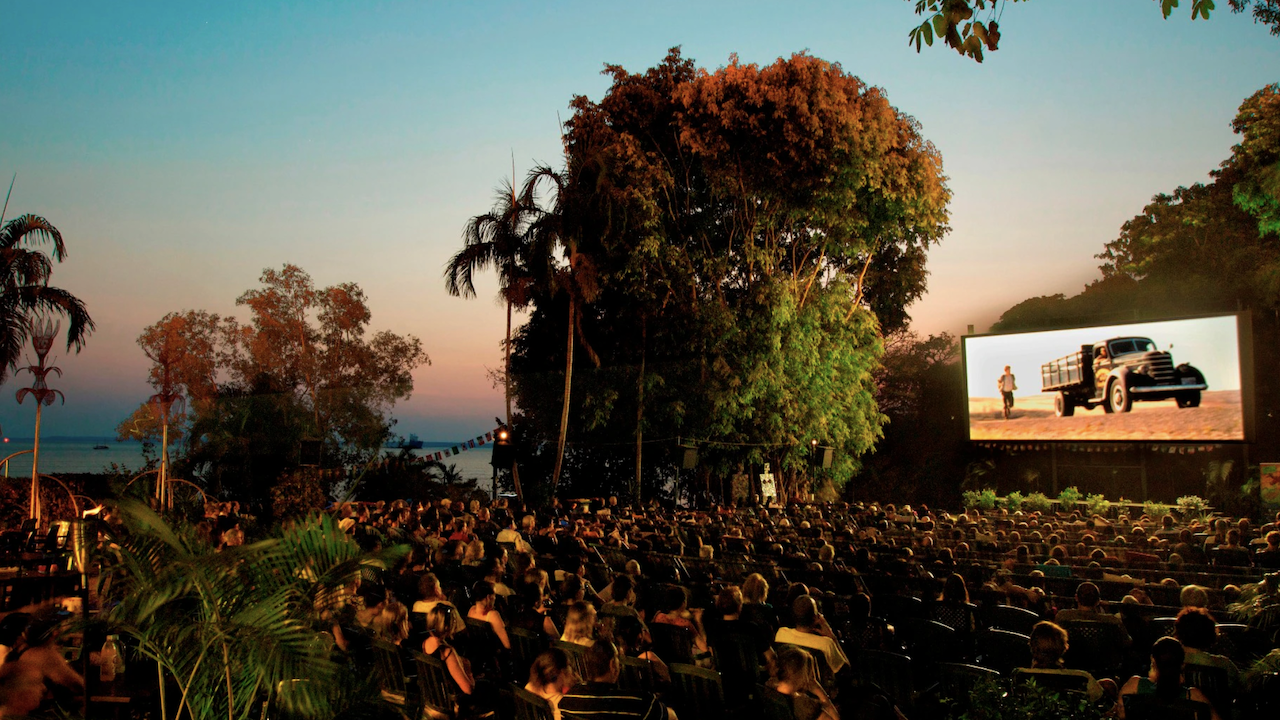
Deckchair Cinema, Darwin City, NT
Where better to set up a chair in the great outdoors and watch a flick than in the tropical heat and light of Darwin Harbour? Allowing for closure during the monsoon season, the cinema operates from mid-April to mid-November seven nights a week, opening at 6pm. Attendees access the cinema via walkway from the city esplanade, and with plenty of parking and bike racks, the venue is perfectly accommodating for locals and tourists alike.
A fully licensed kiosk offers snacks and drinks, while local caterers can provide dinner. This might include a fragrant Nepalese goat dish, Indonesian dishes from authentic Sumatran recipes, Sri Lankan cuisine, Syrian falafel, kebabs or spit-roasted lamb, Korean fried chicken, Japanese, quiches, or moussaka.
The venue is family-friendly, wheelchair-friendly and non-smoking, with toilets on site. Since 1994, the Darwin Film Society has operated this as the only independent cinema in the city, also running Flix in the Wet from January through March and the annual Darwin International Film Festival in September.
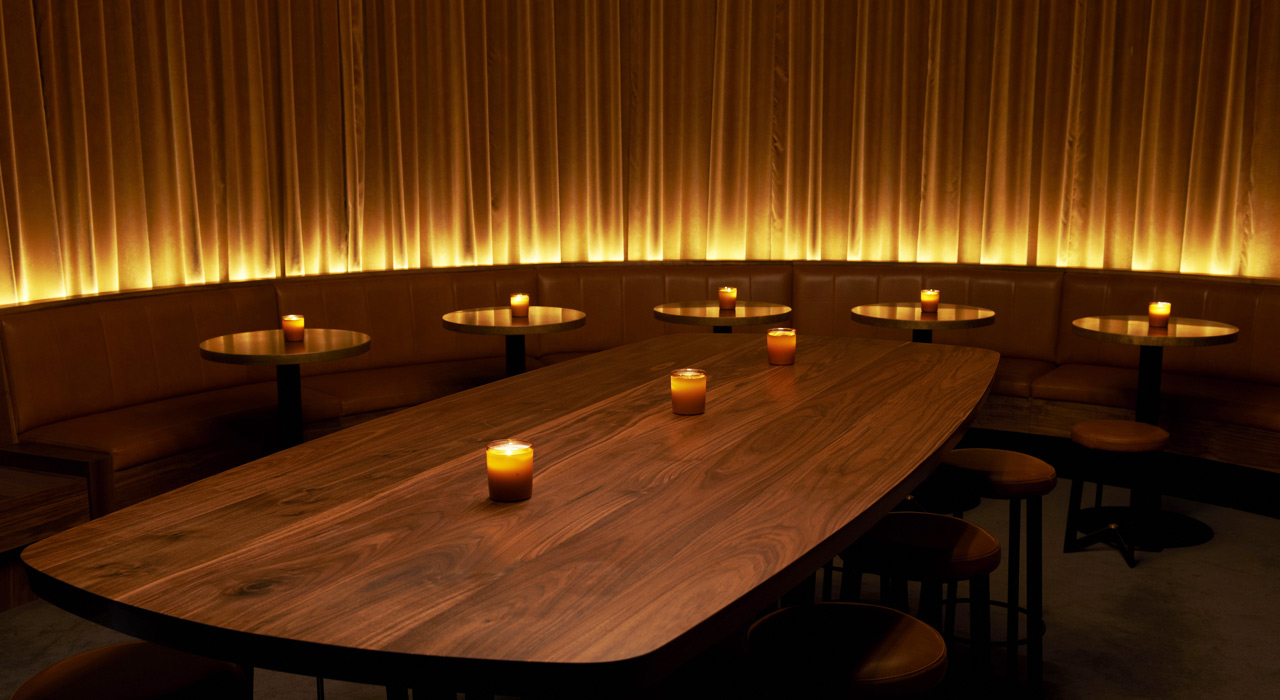
Golden Age Cinema and Bar, Sydney, NSW
Sydney’s Golden Age Cinema pays homage to its 1940s origins while embracing all the fundamental contemporary technology and creature comforts to ensure film lovers have an immersive experience. Below street level, the cinema is located within heritage-listed Paramount House in Surrey Hills. The program is also underground to a degree, offering curated classics, and art house and cult favourites, as well as the latest releases. The cinema, originally run by Paramount Pictures, was used to screen news of war in the mid-1940s.
The David Lynch-inspired Bar, complete with original art deco fittings and thick, gothic drapes, is designed for 60 people, providing an intimate and luxurious atmosphere for pre-screening drinks (cocktails, beers and wines) and snacks or post-movie discussion and canoodling. Behind this underground treasure are the brothers Barton—Barry, Bob and Chris—who took over in 2013, determined to craft the theatre into the retro-luxe offering it is today.
Bulb lights hang low over amber-hued floor lights, and the scent of rosemary entices hungry and discerning foodies. The herb and parmesan popcorn is popular, but salted maple or simply sea salt are all on offer if you desire. Sweet tooths might opt for the choc-top. The Zurich-sourced 1940s cinema chairs are not the Michelin-man pillows that mainstream cinema goers may be accustomed to—and all the better for it, we think.
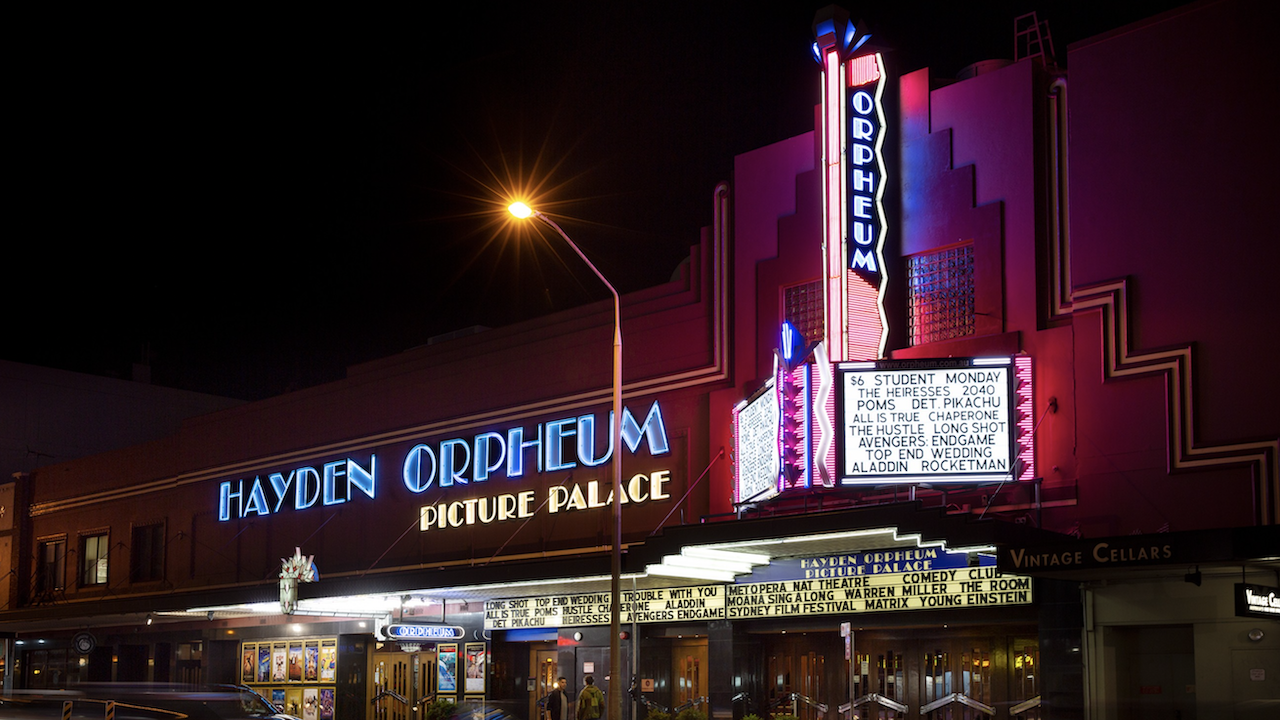
Hayden Orpheum Picture Palace, Cremorne, NSW
The heritage-listed Hayden Orpheum Picture Palace was once the Cremorne Orpheum Theatre. Architect George Newton Kenworthy designed the building, erected in 1935 in palatial style. Stained-glass windows, neon-lighting, heavy velvet stage curtains over the screens and regal red seating all make for an elegant experience. Originally the dress circle of the Orpheum theatre, the main auditorium is now protected by National Trust.
The Orpheum has a seating capacity of 700, and the original art deco-style statues of Princess Atalanta of Arcadia holding suns and sun rays remain under a wash of coloured lighting from the ceiling panels. Kenworthy also designed the Enfield Savoy Theatre, the Majestic Theatre in Port Macquarie, and the Regent Theatre in Mudgee—all in his distinctive art deco style.
Though the Orpheum Theatre is reason alone for design aficionados to attend, the 1925 Wurlitzer pipe organ that was installed in 1987 is also a drawcard.
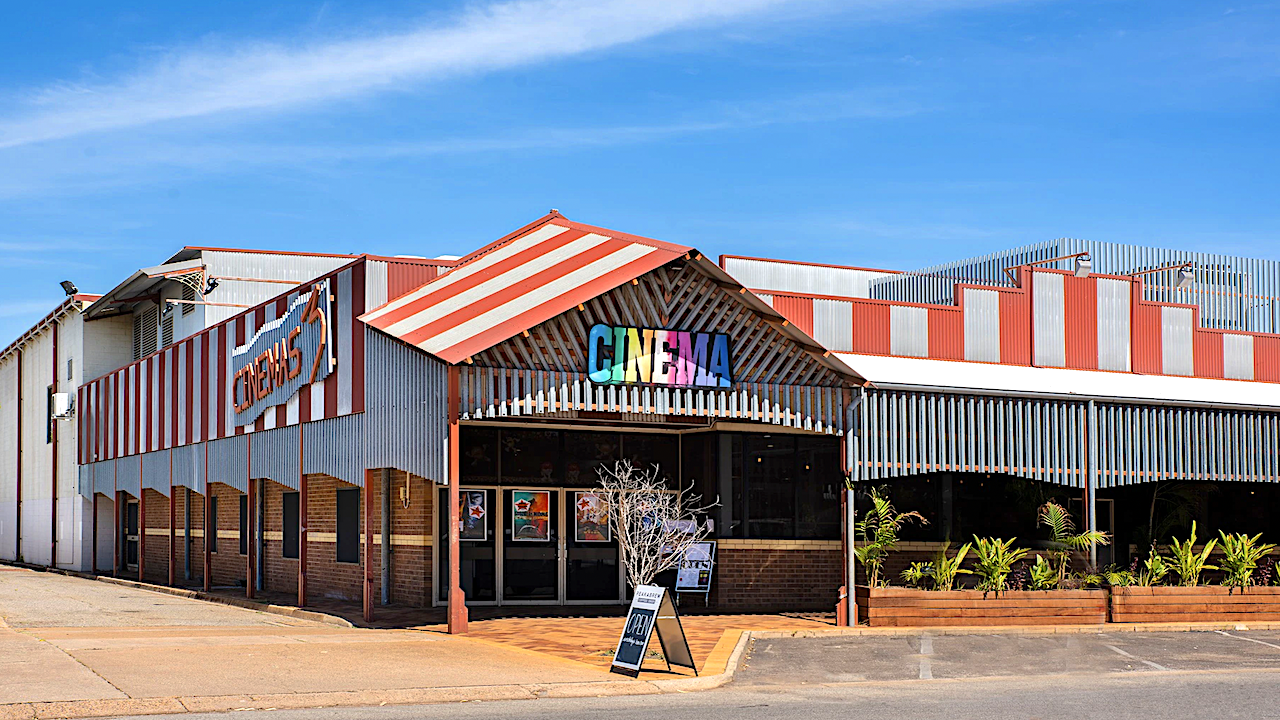
Katherine Cinema 3, Katherine, NT
While “beautiful” cinemas might revel in their art deco forms and grandeur, Katherine Cinema 3 is a humble example of beauty that results from functionality, simple shapes, and its role in the heart of community. The art deco style block shapes that rise from the roof are painted in striped rust and white, while rainbow lettering announces “CINEMA” above the glass-fronted doors.
It’s a simple, brick building, shaded from the harsh sun by roofing that extends over the street-level pavement. Katherine Cinema began operating as Star Cinema in 2020. Then in July 2021 it was retitled back to its former name, Katherine Cinema 3, when the business was bought by its present owner, Ethan Grahek. Grahek is dedicated to continuing a strong community-centric focus, screening locally-produced ads for local businesses, and hosting the local Katherine Film Society.
Grahek intends to modernize the business by installing TVs and an up-to-date ticketing system, with the intention of improving customer service standards, and, he says, “getting a large fridge to keep all the chocolates to prevent them from melting, because the temperature in the NT is very hot. We’ve also updated the air conditioning system—making the cinema a great place to go to cool down.”
To entice the locals, including RAAF personnel from the nearby Base Tindal, Grahek will be showing footy matches and leasing the theatre for video gamers, birthdays and private sessions.
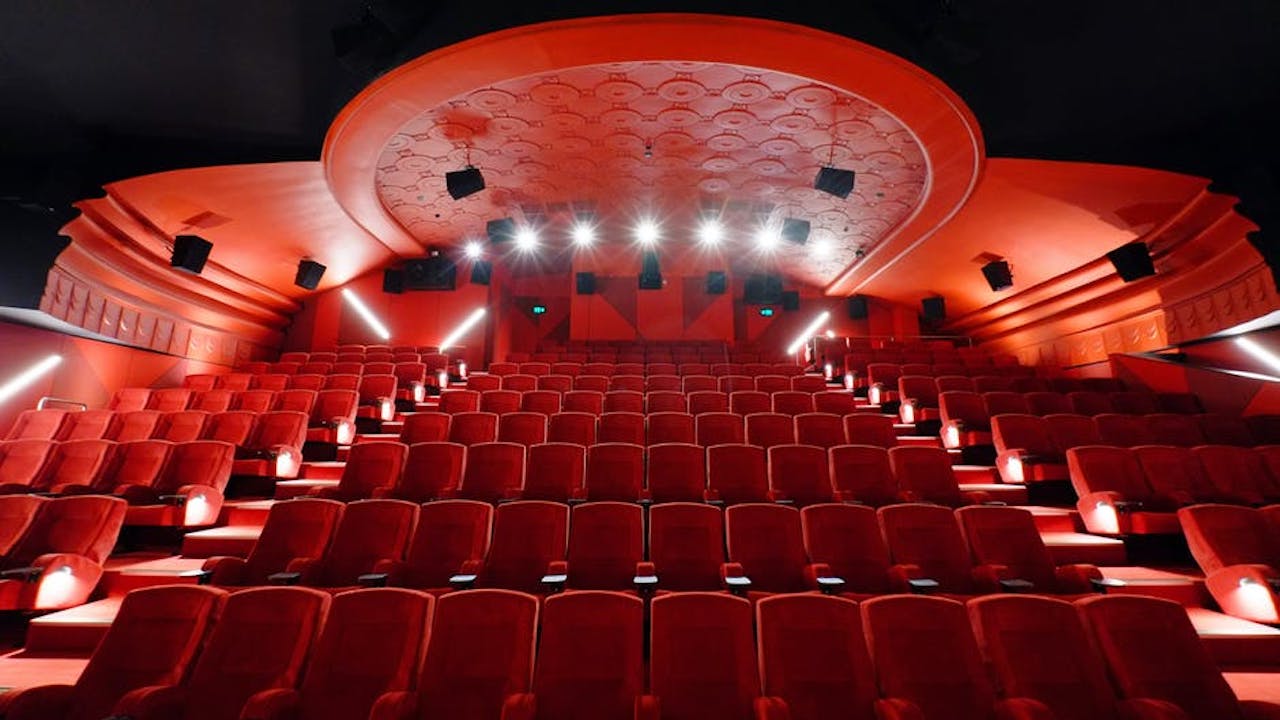
Lido, Hawthorn, VIC
Lido is located in the suburban heartland of Hawthorn, set back from Glenferrie Road above a shopping strip arcade. If you weren’t seeking it, the cinema could well remain a mystery to anyone passing through the arcade. Those who do venture upstairs will find a contemporary entertainment and hospitality destination that took four years of renovation to perfect.
The original Lido opened in 1912, furnished with the design elements that were chic at the time: leadlight windows, plaster ceilings and carved handrails. The renovation in the early 2000s focused on colour, light and texture. The original staircase is painted in bold red, as are the floors and ceilings.
Along with the original Victorian windows overlooking Glenferrie Road, two stained-glass windows were installed. Primary colours are the heroes—with deep blue ceilings in the first floor foyer and punchy green, mint and sunset oranges in geometric panels along the walls and ceilings. Original features have been retained to a degree, with the original marble and terrazzo floors remaining. Lido is not all surface success though; it houses eight cinemas (with capacity for 58 people through to 220 respectively), a jazz club for live music, and a rooftop for outdoor screenings when the weather permits
“The building has had many lives: a theatre, cinema, cabaret venue, pool hall and dance school, with elements of many incarnations preserved,” says Aidan Halloran of ITN Architects. “A futuristic noir feel was inspired by the style of Godard’s film Alphaville, using the darkness of the predominantly windowless space to create dramatic shadowy contrasts and colour plays. The toilets feature wallpaper made from actual film scripts.”
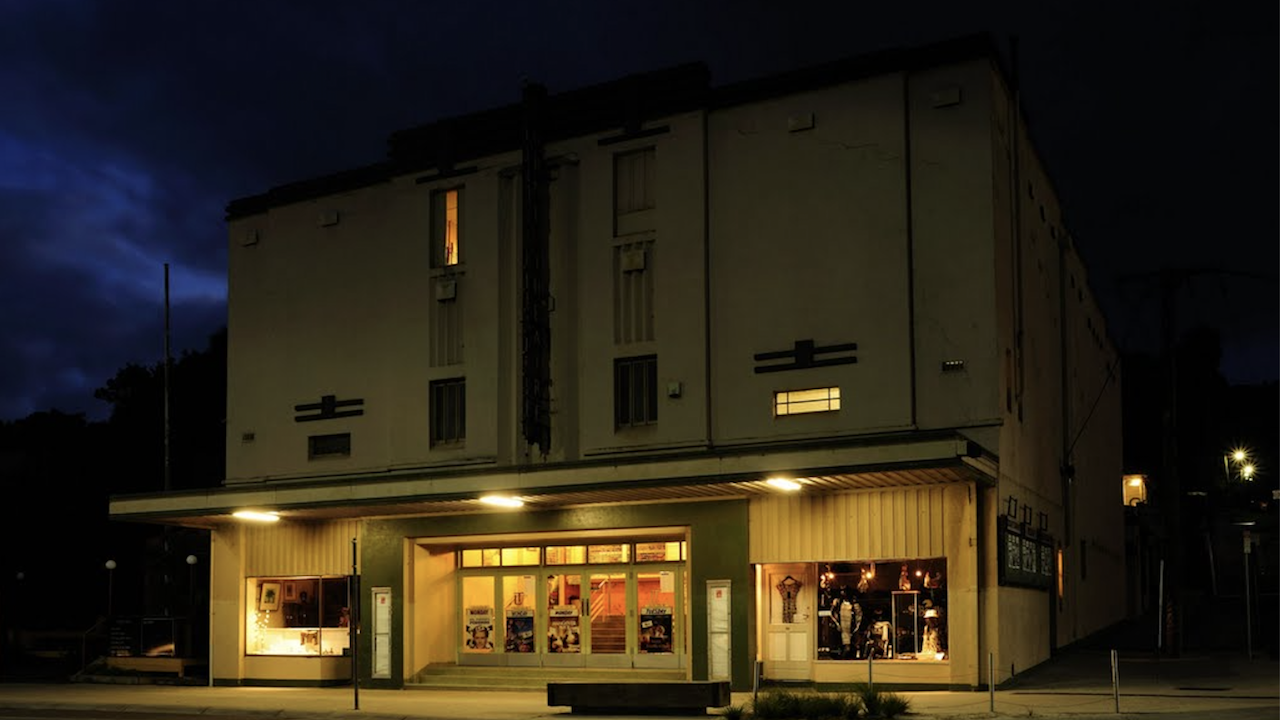
Lorne Cinema, Lorne, VIC
For the majority of tourists to Lorne, the draw cards are the beach, fish and chips and the Lorne Pub. They’re missing out if they don’t stop into the Lorne Cinema, though. Built in 1937 and opened by the Lorne Picture Theatre Company, this lovely two-storey, art deco building is a humble beauty. The rendered concrete facade above street-level windows is a throwback to the simplicity of an older age, and fitting for a single screen cinema designed to entertain locals in a regional destination. The salty sea air has aged the exterior, and there’s a lingering scent of hot chips and coffee upon entering.
The seating is old-fashioned, which could be romantically nostalgic or horridly uncomfortable depending on the health of your hips. Understandably, this gorgeously rebellious cinema that refuses to modernise either its ticketing or seating is listed on the Victorian Heritage Register.
The cinema was built to encourage visitors to the quaint seaside town of Lorne upon the opening of the Great Ocean Road in 1932. Equally nostalgic are the candy bar, selling lollies and soft drinks. The vibe is family friendly, though the cinema shows everything from art house and foreign films to the most recent releases.
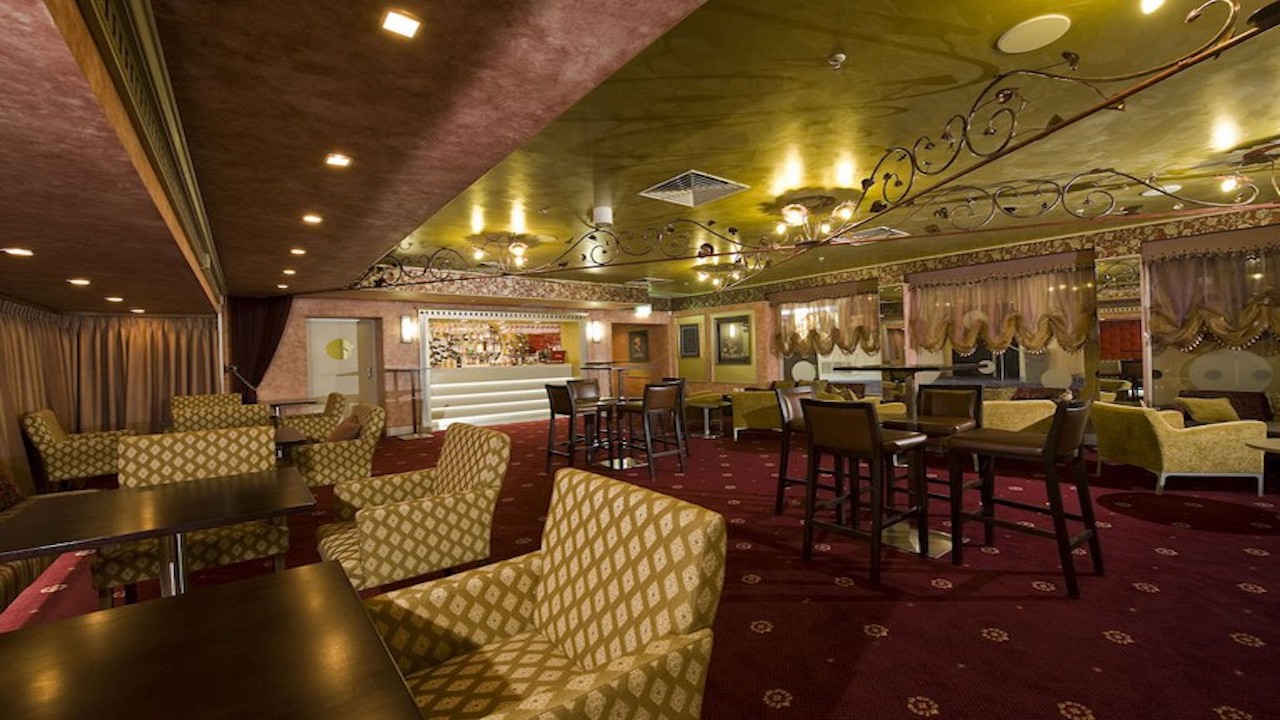
Wallis Mitcham, Adelaide, SA
Located within Mitcham Shopping Centre, Mitcham Cinemas is a mecca for locals seeking the latest major releases. With seven screens, there’s plenty of choices across the daily schedule. The licensed Boulevard Lounge is a classy affair, offering an array of savoury and sweet snacks through to full meals, alongside a good selection of wines and spirits.
The ornate ceilings are warmly lit, and plush carpets and lounges perfectly accommodate a date night, or a family night out. The lounge area is furnished with high stools and tables, 1940s-inspired decorative wallpaper and curtains to shield the space from the shopping centre surrounds.
If the lounge is too formal, the candy bar is suitably old fashioned, with snacks and soft drinks galore. A long, narrow entry foyer where the ticket kiosk and candy bar are located to one side is studded with couches and padded seating. Though the shopping centre is modern, multi-level and well-lit, upon entry to the cinema (and the Boulevard Lounge in particular) there’s an air of the excitement that has always accompanied cinema going. The amber glow of the lounge, easily identifiable via a neon sign, should rightfully draw you in, pre-movie or post-movie—or both.
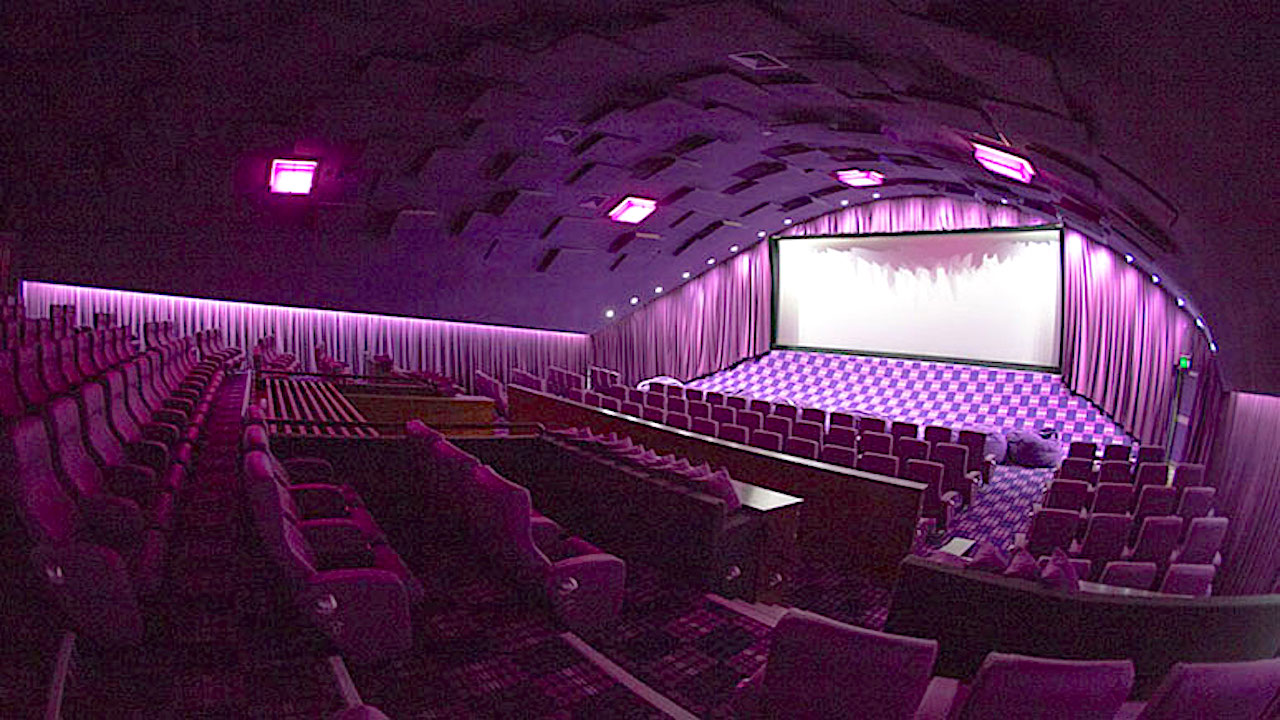
New Farm Cinemas, New Farm, QLD
Built in 1920, New Farm Cinemas was originally the Astor Theatre, then the Merthyr Picture Palace and, in 1970, became the Village Twin Cinema Complex. Though not heritage listed, facets of the original heritage-listed Village Twin Cinema remain in the current design. Brisbane architect Claude E Humphreys was commissioned in 1924 to revitalise the Merthyr Picture Palance, and he designed Greek palatial style front facades, which remain largely unchanged.
In 1970, the cinema was converted into a twin cinema complex that divided the existing cinema into two back-to-back theatres with a shared projection box. The foyer boasted a fountain and copper Gemini figures (twin cinema, of course). From 2003 to 2011, the cinemas were closed and abandoned. The deterioration raised fears of demolition, and when the building was acquired in 2013, the restoration was able to salvage parts of the theatre along with adding four screens to result in a six screen theatre in 2014.
The most ornate of the original cinemas, the Blue Room has a high vaulted ceiling, resembling a cosmic landscape of moon craters, layered with red, blue and green lights. The swirling dot pattern carpet rises a metre up the walls, with lush turquoise curtains draped from ceiling to floor. Upon refurbishment, The Purple Room became the flagship cinema, accommodating 224 people under its high vaulted ceiling, concealing purple light boxes under layered square panels. The seating configuration is the same as The Blue Room, though seats are upholstered in purple vinyl and the carpet is—suitably—purple.
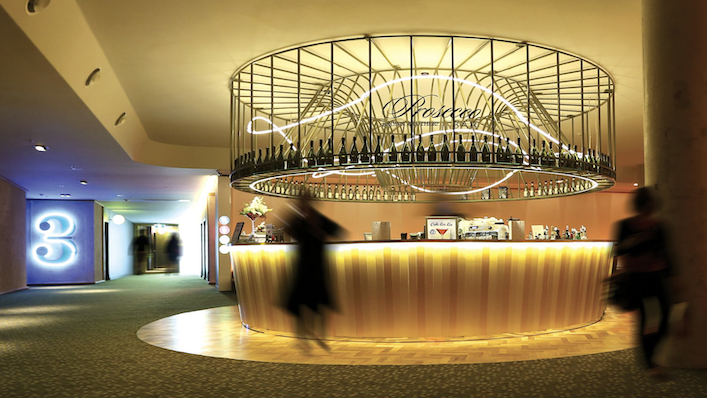
Palace Electric, Canberra, ACT
Within Canberra’s Palace Electric, a circular bar is futuristic and strangely sci-fi in design. The prosecco bar, located in the foyer of the cinema, seems to rise—lit from within—from the floor, with a metal cage lined by wine bottles hung overhead. It’s dramatic and a nice focal point to draw in patrons who may or may not have intended on seeing a flick. The eight screen cinema (all fully licensed) is located within NewActon Nishi complex, with substantial parking, public transport and cycling facilities.
Within the cinema theatres, comfy modern tiered seating provides clear views to the screen and there can be no doubt which cinema is which, with large neon numbers at each auditorium entry door. The cinema is glorious, but the Nishi complex itself deserves exploring.
Built to be sustainable and efficient, the award-winning complex houses 220 residential apartments and commercial office spaces behind one of Australia’s biggest timber facades, which also houses 90 plant boxes. The whole design champions natural light, environmentally-friendly timber and spaciousness.
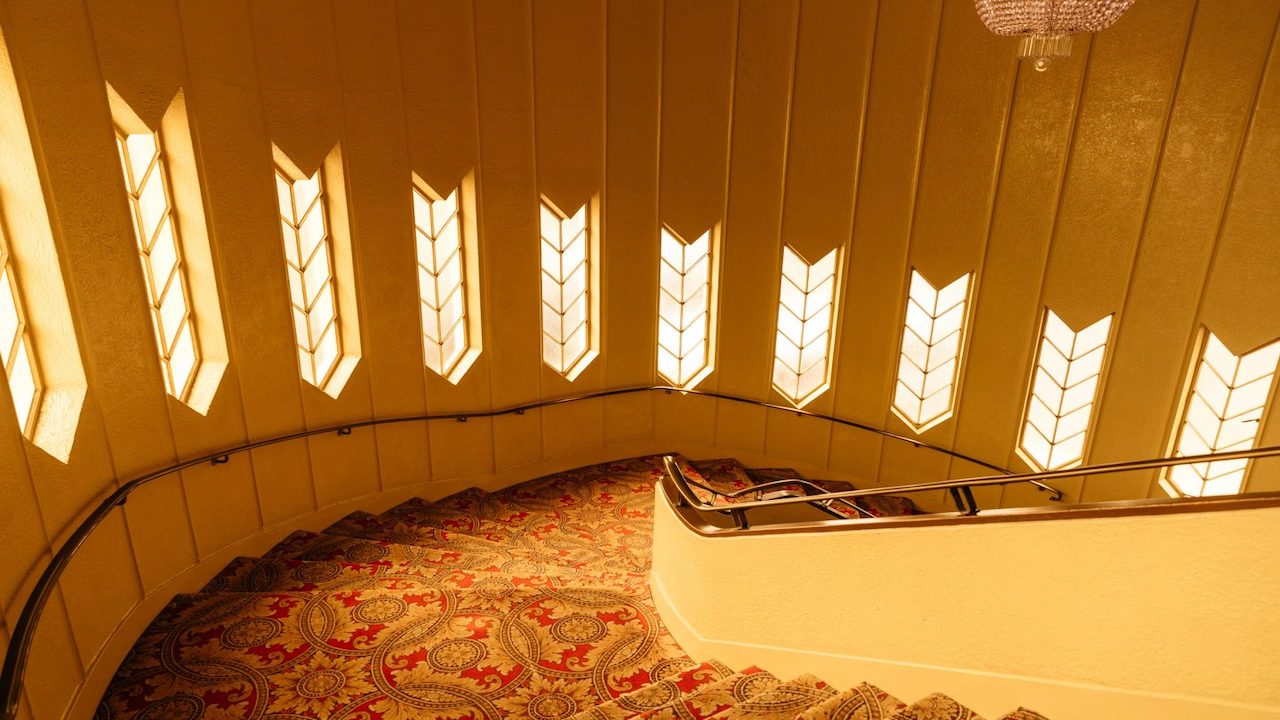
Piccadilly Cinemas, North Adelaide, SA
Within a bustling area of North Adelaide, Piccadilly Cinema is located among restaurants, cafes and shops. It is an ideal combination of old and new, luring design aficionados with its historic art deco features while also attracting modern cinema goers who expect the most current technology and comfort. Now a triple screen cinema, it was originally a single screen cinema with seating for 1,437 upon opening in 1940. It closed as a cinema in June of this year with renovations to turn it into a multi-functional space housing a bar, events venue, and film festival hub upon reopening in June of 2022.
The high curved facade rises from the street corner frontage, topped by old-fashioned letters spelling out “PICCADILLY.” Columns outside the glass panelled doors are lined with the posters of movies currently playing. The building is a glorious throwback to an era when Australians were seeking escapism from news of war, and places of entertainment were grand oases of escapism from the bleakness of everyday life.
An elegant, carpeted and curved staircase leads from the entry level to the upstairs, providing views to the outside through porthole and arrowhead-shaped amber-glass windows. A large mural facing onto the staircase was designed by South Australian School of Arts head, F. Millward Grey, depicting—what else?—London’s Piccadilly Circus.
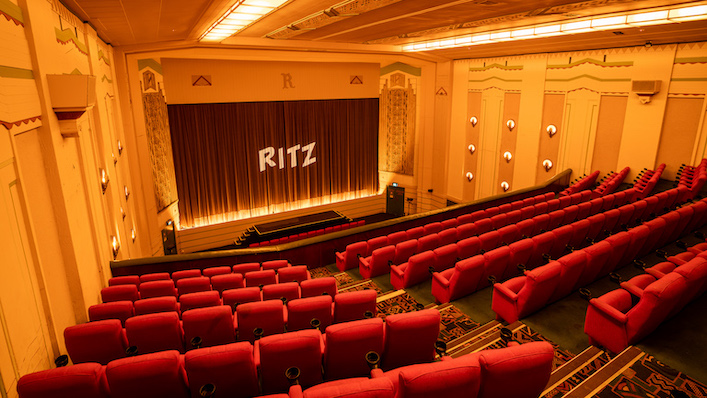
The Randwick Ritz, Randwick, NSW
Built in 1937 to a design by prominent Sydney architect Aaron Bolot, the imposing Ritz Cinema was heritage listed in 1999 for its valuable example of the art deco style. The double-level brick building is a wonderful study in geometric simplicity, resembling a skyscraper in its narrow, upward shape that is emphasised by vertical ribbing and reeding.
The facade boasts its original street awning over the foyer doors, decorated with the contrasting curves and sharp lines of an art deco motif. The interior, redecorated in 1963, is softer, with the main staircase located within curved walls and corners in both the foyer and lounge. Within the auditorium, panels along each side of the screen are typical art deco style lights. The ceiling and walls are adorned with plaster patterns, and the speaker boxes too are detailed decoratively.
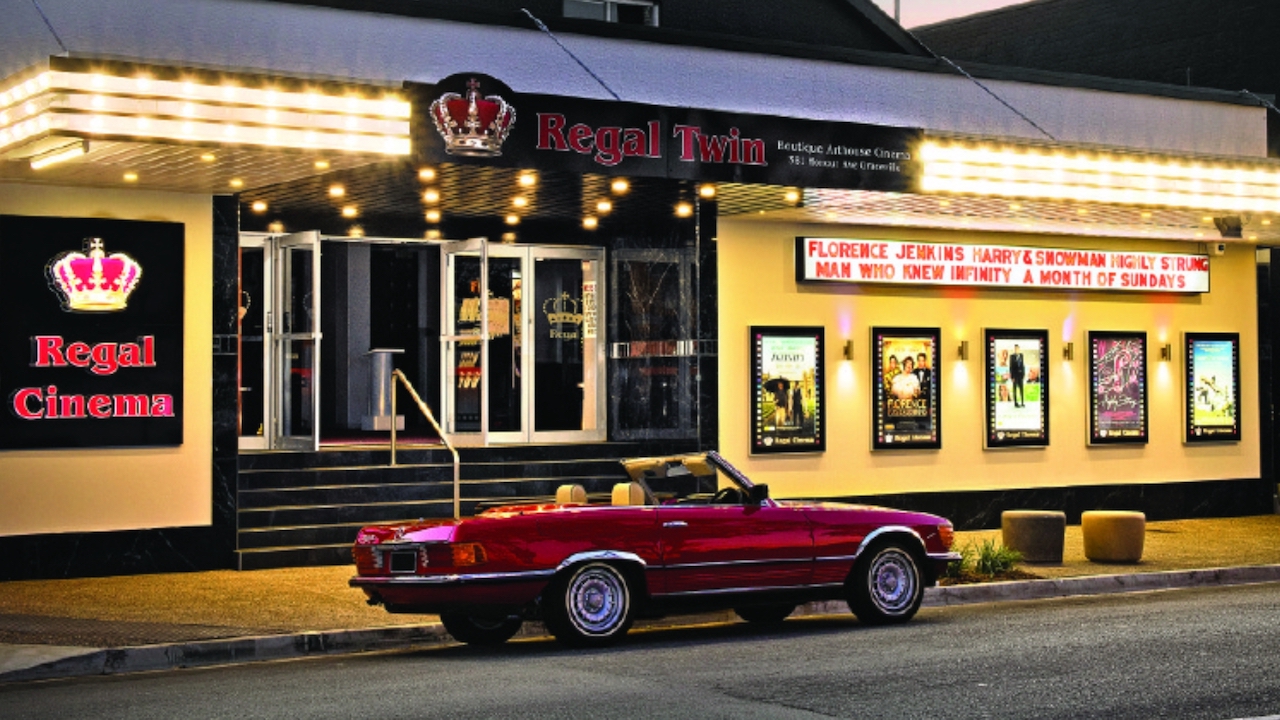
Regal Cinema, Graceville, QLD
The Regal Twin is one of those lovely, humble local cinemas that glances at its glossier, flashier competitors and takes a disinterested yawn. It remains one of the oldest picture theatres in Brisbane. The twin cinema rests on hallowed cinema ground, with the site originally occupied by an open air theatre—Graceville Picture Gardens— that was popular during the silent movie period of the 1920s. In the 1930s the cinema was built, renamed the Regal in 1953 upon Queen Elizabeth’s coronation, and “twinned” in 1995.
The building is a single storey, blockish structure in the modernist art deco style, lit by a rectangular neon sign advertising the names of the movies currently screening. Its horizontal lines, curved corners, and lack of adornments speak to elements of functionalist design, free of the frills and fuss of other designs of the 1920s and 1930s. Below the neon signage, framed movie posters lure cinema goers to each new title.
Art house is the vibe, with foreign language and independent films championed on the regularly rotating schedule. The ticket kiosk and candy bar are immediately identifiable thanks to rainbow-hued neon lettering reading “ice cream,” “popcorn” and “sweets.” Whether it’s for the historic building or the arthouse offerings, this cinema’s charming lack of pomposity deserves your attention.
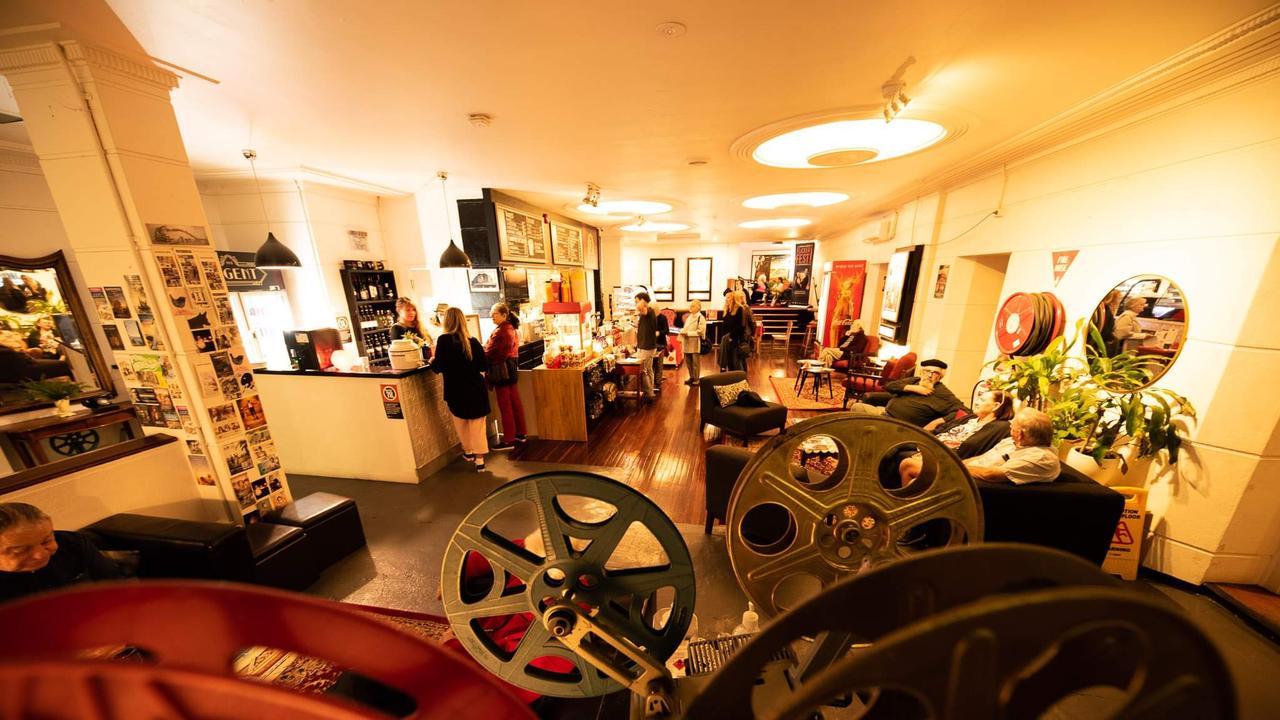
The Regent, Murwillumbah, NSW
“The Regent deserves to be on the list of most beautiful cinemas in Australia, with her art deco magnificence,” says business owner and manager Allira Cornell, who took over management in 2020.
It was built in 1947, initially designed to seat 999. The area that is the cinema now was originally the dress circle and VIP bar. Tiered seating for 250 remains and the last owner (Mr Ken Rippin) secured several grants, adding a stage in front of the screen for live performances, as well as solar power to run it.
“The building has survived floods, which in 1974 reached the balcony, and a fire in the back half,” explains Cornell. The fire damaged area is currently being restored and renovated by building owner Stephen Webb, who purchased it in May 2020.
“I have lovingly refurbished the interior with plush deep red carpet and an extended bar along our balcony,” she says. “I’ve also organised for live music, poetry, kids shows, comedy and soon cabaret in addition to our single screen cinema offerings. I have discovered a new passion for bringing interesting content to my regional audience.”
Weekends are for live music on the balcony, and the on-site cafe offers a broad variety of food along with a licensed bar.
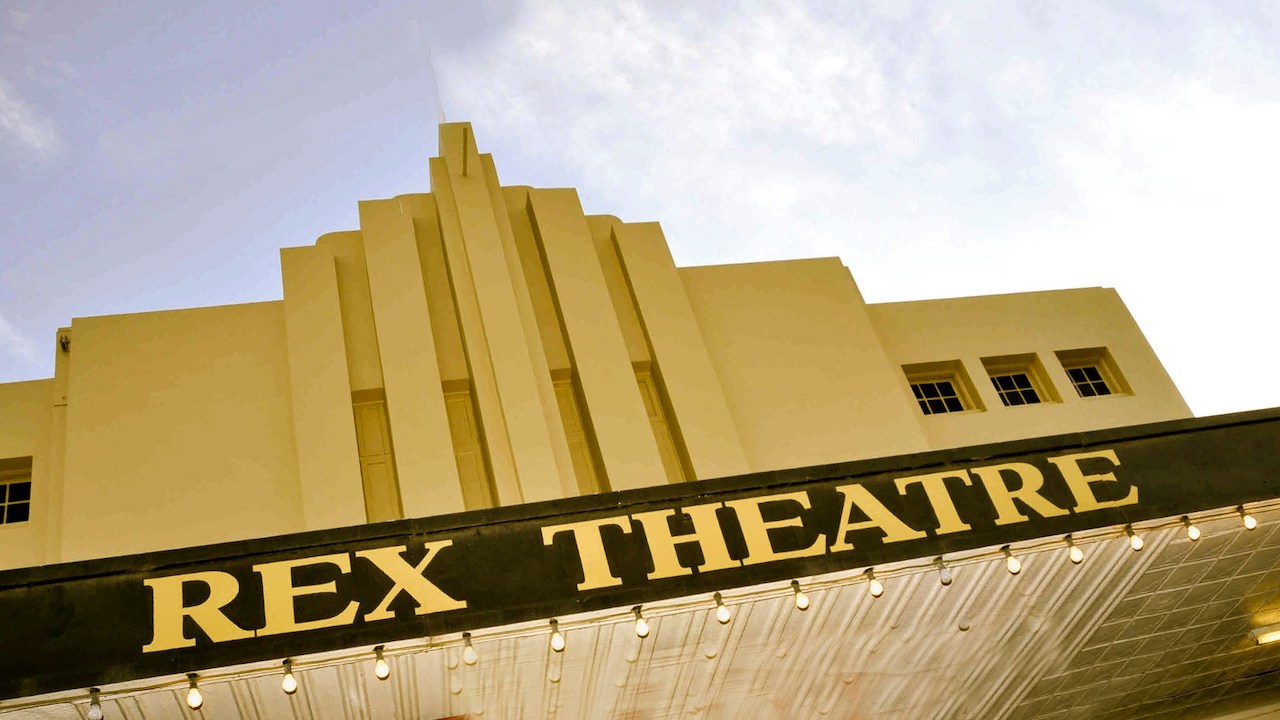
Rex Theatre, Charlton, VIC
A truly community-owned and managed affair, the Rex Theatre in north-western Victoria is equally a historic monument and a modern, elegant cinema. Its sheer high-rise facade is formed from a classic art deco design, and the glass-front panels provide full vision into the foyer of the theatre/cinema. It is more than visually beautiful, being the last purpose-built and original cinema in country Victoria.
The same building erected by local builders in 1938 remains, with only minor alterations over time to enable the installation of new projectors. Amongst the old-fashioned, romantic relics are a popcorn machine, a wooden ticket kiosk in the central foyer, and grand port-coloured carpeting. After flooding in 2011, a restoration gave a fresh overhaul to the interiors, but the original fittings and decor have been restored rather than changed.
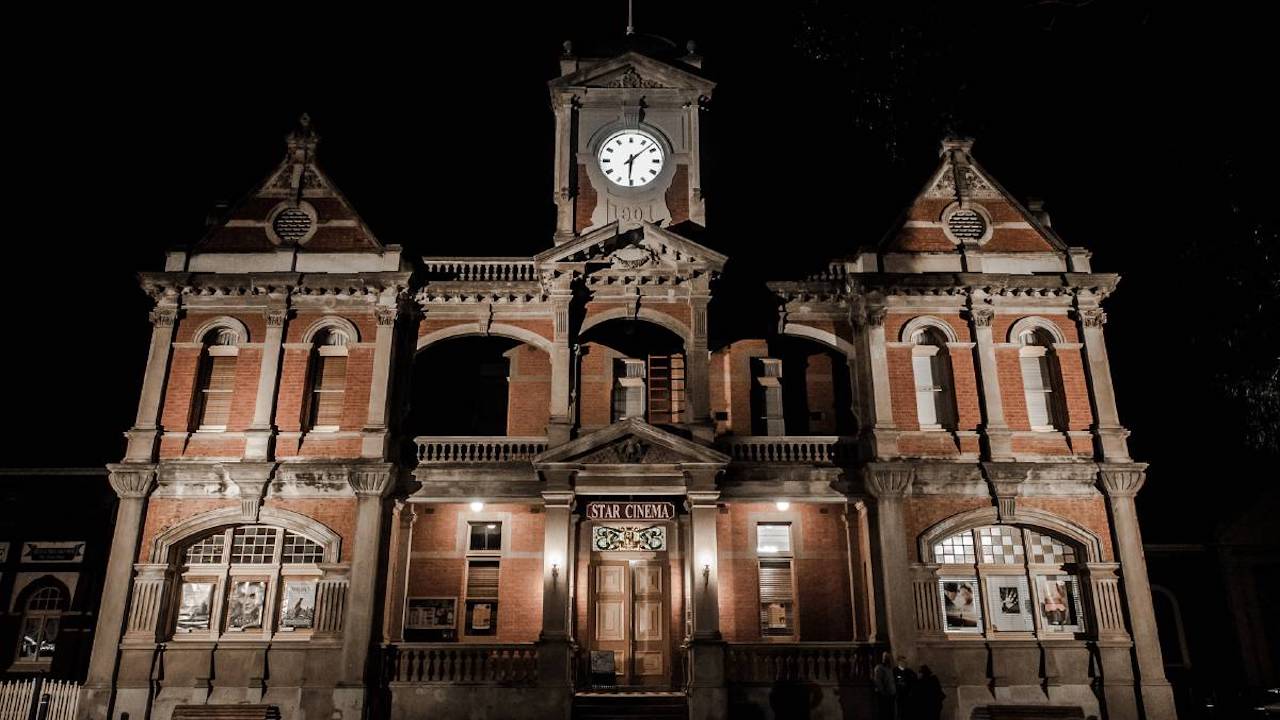
Star Cinema, Eaglehawk, VIC
A mere 10 minutes from Bendigo, Star Cinema is located within the Eaglehawk Town Hall. The original cinema Star Pictures originated late last century, though it suffered from a lack of interest in the 1960s and closed until Joan Rodger reopened the cinema, now Star Cinema, in 1999. She replaced the hard seating with cushioned chairs, and obtained a license to allow attendees to order wine, cider or beer.
When Rodger retired in 2004, a group of impassioned locals founded the Star Community Cinema Association and took responsibility for operating the cinema from 2005. The original ticket booth and projection room remain fundamentally unchanged since the early 20th century.
Uniquely, the single screen cinema is furnished with couches and armchairs rather than traditional cinema seating. There’s choc-tops, even if there’s no fresh popcorn, but better than sugary snacks are the timelessly elegant wooden floors, decorative plasterwork and soaringly high ceilings. There’s easy parking and an unfussed atmosphere to the venue, which is refreshingly different to the bustling, noisy cinemas of suburban metro shopping centres.
Refreshing, also, is that the cinema is staffed largely by volunteers, with a dedication to fundraising events for community groups. Do locals know how fortunate they are? Remind them when you’re there.
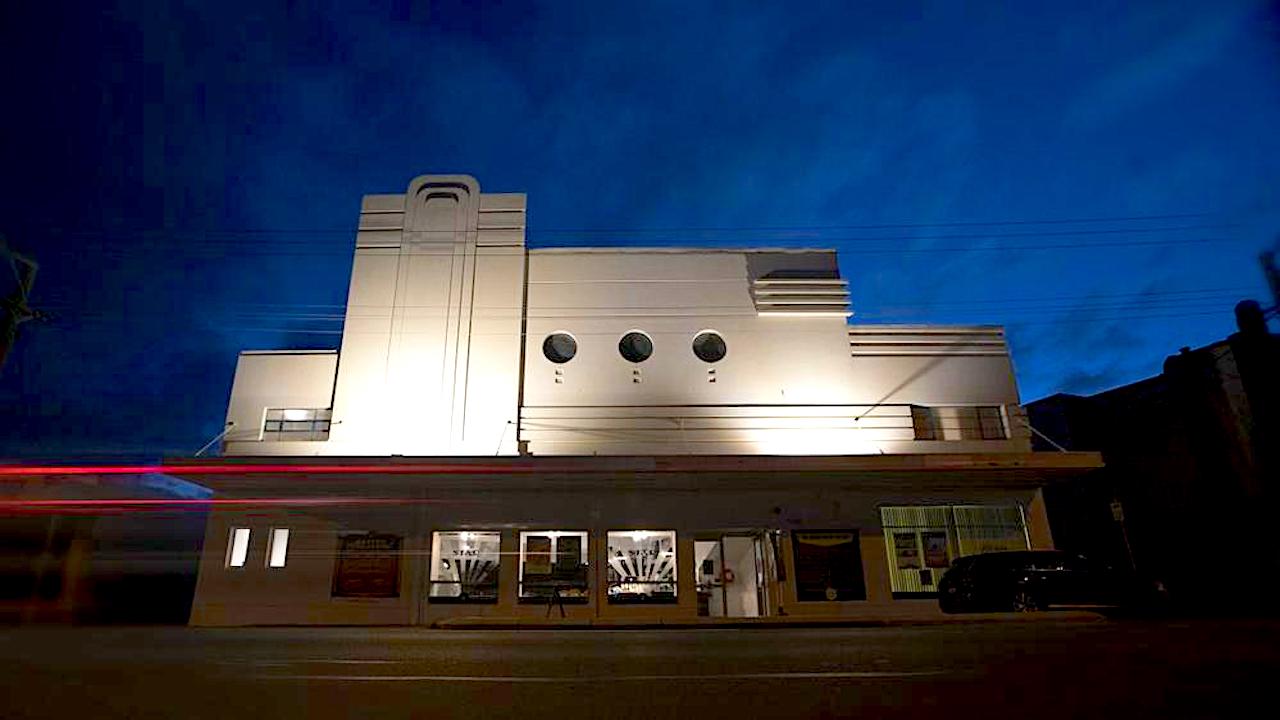
Star Theatre, Invermay, TAS
Another art deco designed masterpiece, the Star Theatre in inner Launceston’s Invermay remains, fittingly, a star attraction for lovers of both movies and architecture. The focus on horizontal lines, simple geometric shapes, porthole windows and classic colours harks back to the original theatre that opened in 1937, designed by Tasmanian born architect Guy Crick. The theatre closed in 1969, operating from 1971 as an op shop until its conversion to an independent cinema, cafe and bar between 2015 and 2018.
In the early 1960s, just over 800 patrons could fit into the building, perhaps occupying the first floor stalls or the second floor dress circle. The current Star offers both cinema and events including live comedy, music and festivals. The focus of the bar and cafe is to champion Tasmanian produce—a boon for locals and tourists alike.
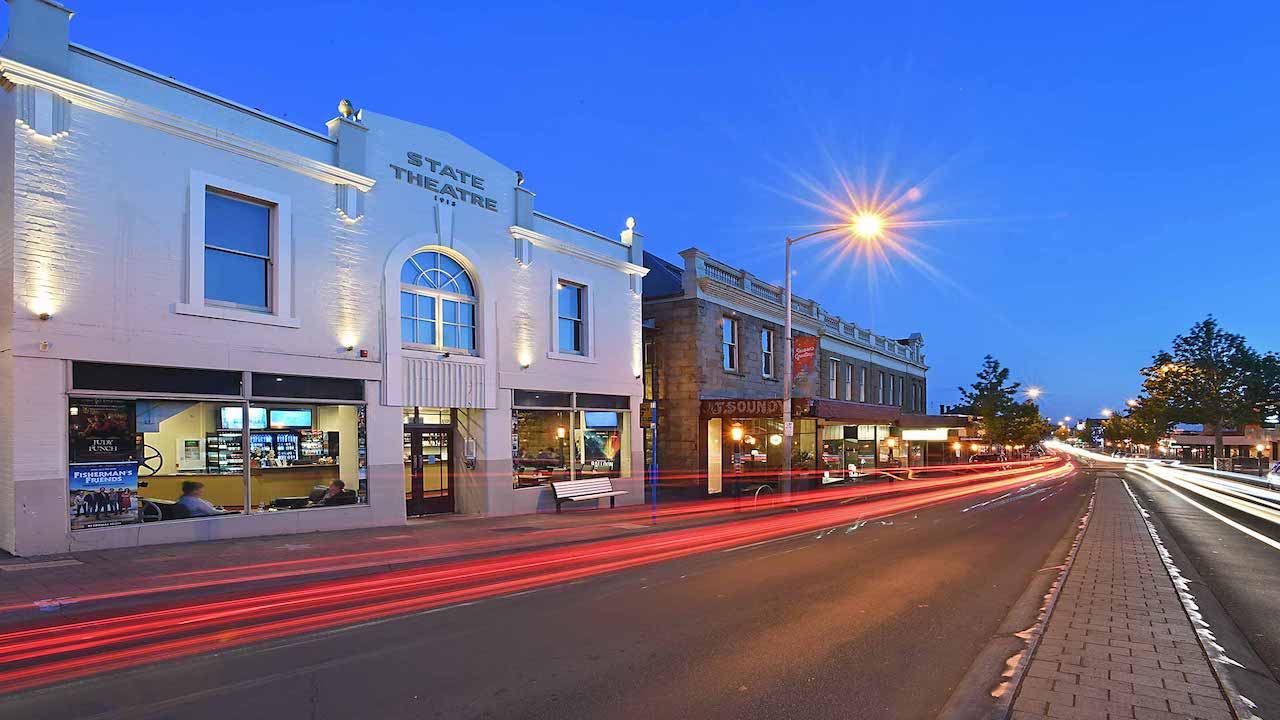
State Cinema, Hobart, TAS
Entertaining Hobart locals since 1913, the State Cinema is indeed stately, with 12 cinema screens and a rooftop bar and cinema. It opened over a century ago as a picture house that also accommodated an orchestra. Two daily screenings and a Saturday matinee attracted the pre-war crowds, for whom cinema was a new and novel attraction.
By 1935, the floor had been lowered and seating returned after a decade in which the building had been operated as a saloon. The cinema changed hands, was mooted for closure, but ultimately the community rallied and it remains an independent art house cinema. In 2005, the lobby was transformed into a spacious foyer, replete with cafe bar. Above that, a new projector and sound system were installed.
The worn and dated facade was given a facelift a year later, seeking to emulate its original 1920s design features. To make the most of the space, Cinemas Four and Five are located underground, accommodating less than 30 people in each. An extension in 2011 allows for additional cinemas—with Cinema 7 lined in bold red decor—and extended, multi-level cafe area, embellished with a mezzanine floor.
The rooftop cinema is gloriously kitsch and cool, adorned with fake lawn, deckchairs and a much more elegant and priceless asset: full-circle views over Hobart’s city, rivers and mountains. The building, a cultural and community mecca, also operates the State Bar and State Bookshop.
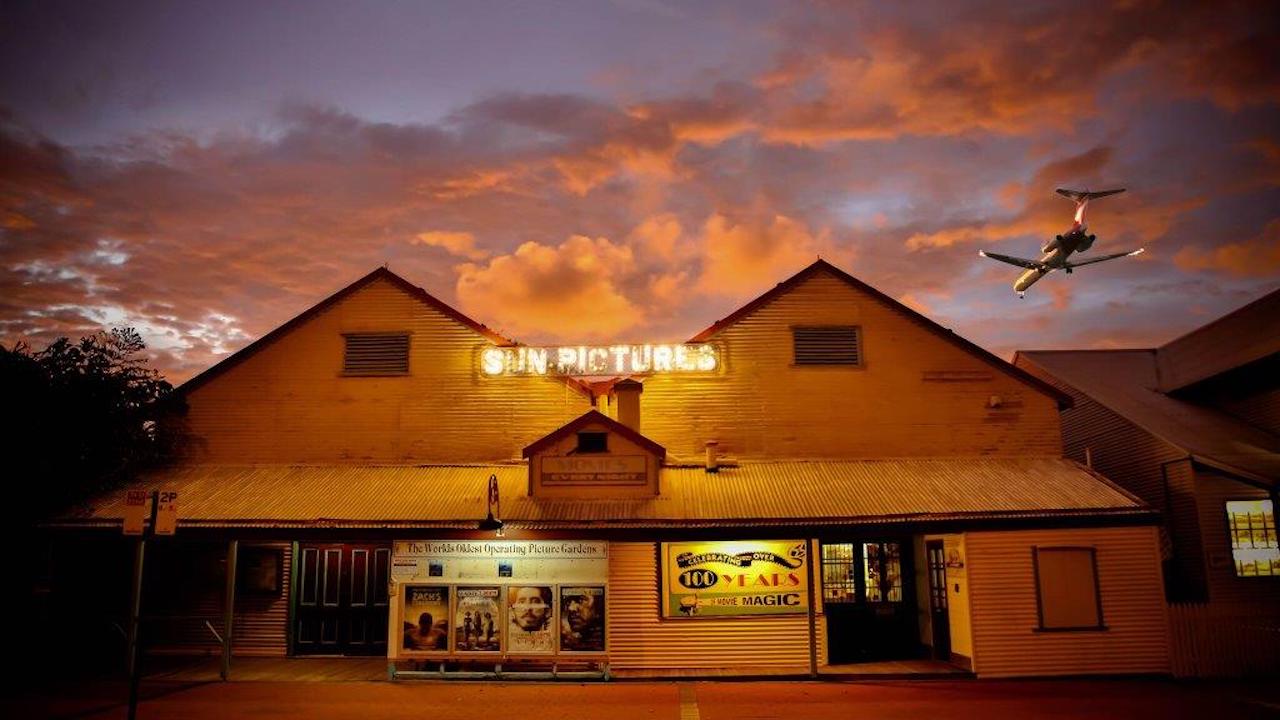
Sun Pictures, Broome, WA
In West Australia’s Broome, Sun Pictures has weathered over a century of unforgiving heat, humidity and rain to remain one of the world’s oldest still-functioning picture gardens.
The unceremonious double-fronted building in Chinatown was built as a shopfront, where the Yamasaki family sold imported Asian foods, clothing and household goods. The family’s love for theatre led them to convert part of the building to a theatre space for traditional Noh performances. When the building was bought in 1913, architect Claude Hawkes was commissioned to design and build a 500-seat picture theatre, which he completed in time for an official opening in December, 1916.
Sun Pictures changed hands over the decades, surviving wartime evacuation, the robbery and vandalisation of projection equipment, and tidal flooding (until 1974 when a levee bank was built across the marsh). The floors were partially replaced in the main auditorium in 2000, along with roofworks that aligned with its heritage listing, having been officially added to the State Register of Heritage Places in 1995.
The building was used as a location for the Australian musical Bran Nue Dae, hosting the premiere of the WA-made film in 2009. It remains a throwback to the simplicity of its original design, tin roof and storefront pavement intact. Unlike most outdoor cinemas, it screens multiple films per night; the majority of outdoor cinemas screen one or two films a week.
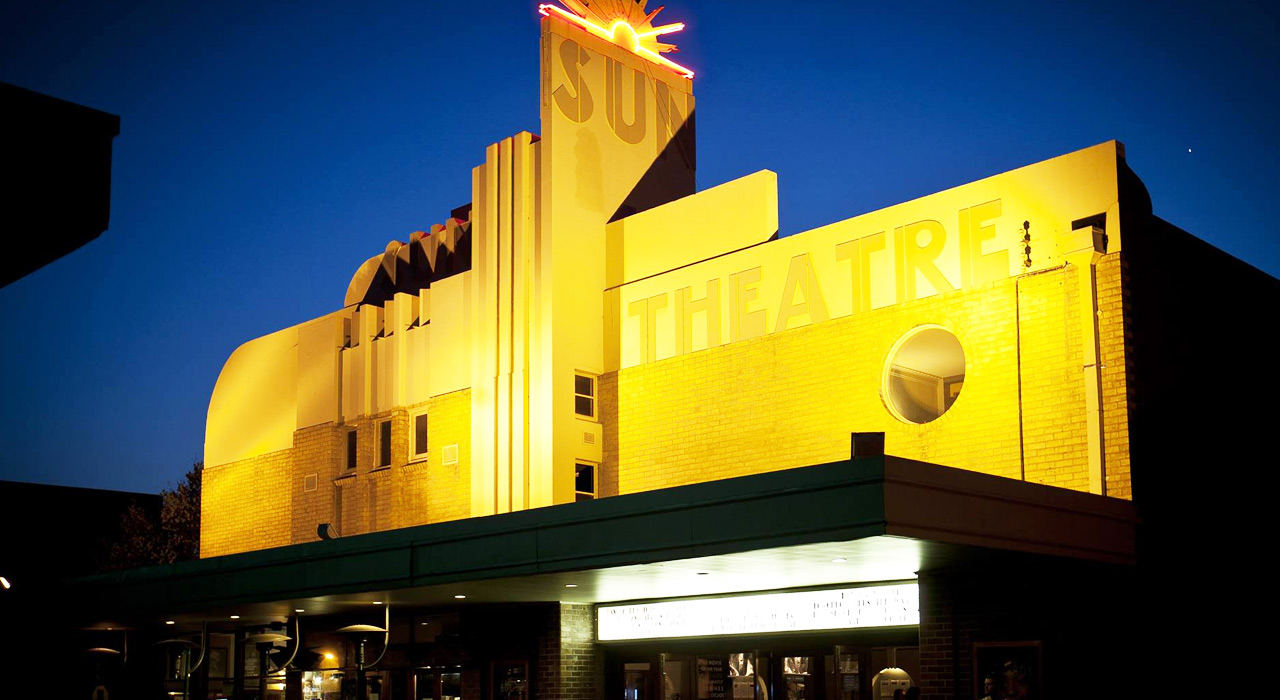
Sun Theatre, Yarraville, VIC
To enter the grand entrance foyer to The Sun, with its expansive parquet floors and curved, gilded ticketing and bar area, it’s difficult to imagine that it began so modestly. When the Yarraville venue first opened in 1938, it offered a single screen cinema with a capacity for 1050 seats. Since Michael Smith bought it in 1995 after the graffitied and crumbling building had been closed for 18 years, it has burgeoned to eight cinemas of varying capacities—each remaining small enough to enable a sense of proximity and intimacy with the film.
The architecture and fixings have remained true to the original art deco style, including curving signage, ornate metal beams, brass furnishings and wood finishes all romantically bathed in yellow-gold lighting. The club-style cinema seats, originally suede, have been reupholstered in leather for longevity, but the generous leg space remains.
Its “The Grand” cinema is an impressive and stately home for the original Wurlitzer organ donated by Brian Davis, a projectionist at the Sun. The heavily draped curtains over the cinema screen and art deco wall motifs are reminders of this building’s history and Melbourne’s deep love of film.
With it’s golden orbed wall lights and narrow structure, “The Trocadero” feels like being aboard a spaceship. “La Scala” is furnished with leather couches and single seats, like a very indulgent (and stylish) home cinema. Cinema goers can choose a glass of wine and serve themselves through the movie. The range favours Victorian wines that are stored in a climate-controlled cellar on-site. You’ll wish it was your local.





